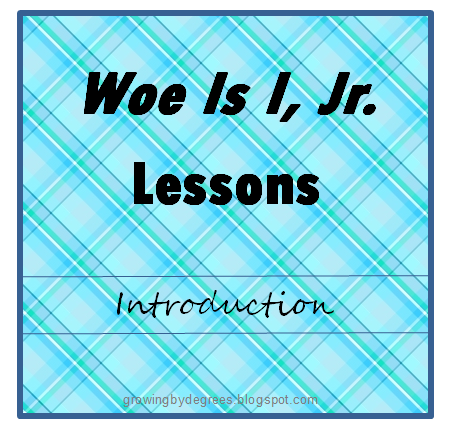I have written lessons to accompany Woe Is I, Jr., a grammar handbook for kids. You can read my introductory comments here, the lesson for chapter 1 here.
1. Read chapter 2 and do what O’Conner suggests.
2. Write five words for each plural ending (s, es, ies) which don’t appear on any of O’Conner’s lists. (You can do this informally or use the worksheet here.) 3. Write about a recent trip to a store. Make every noun plural. 4. Practice your plurals here. 5. Show us what happened at the store in the comments. Go to Lesson 3. Note: This post contains an affiliate link. |

Norma Simon wrote I Know What I Like, a picture book with a very specific pattern.
The first set goes like this:
The first set goes like this:
I like to make pudding.
I like to make pictures.
I like to make faces.
But I don't like to make my bed or pick up in my room. (I do it anyway.)
The rest are like it.
Under Set 1 on the prewriting sheet, write an example together. If you have a student new to writing, the sentences can be simple like Simon's. For students who can do more, encourage longer, more detailed sentences.
Here is one student's example:
I like to (verb)....
I like to (same verb)....
I like to (same verb)....
But I don't like to (same verb)....After reading the book together, talk about the pattern: three likes followed by a don't like. (If you can't find a copy of this out-of-print book, you can still easily do the assignment. The prewriting sheet will help you.)
Under Set 1 on the prewriting sheet, write an example together. If you have a student new to writing, the sentences can be simple like Simon's. For students who can do more, encourage longer, more detailed sentences.
Here is one student's example:
I like to make fresh chocolate chip cookies (and eat them).
I like to make up funny jokes that make me laugh so hard I cry.
I like to make whoopie pies with aunt Elisabeth because we don't see her very often and she makes great whoopie pies! I like it because sometimes Poppop sticks M & M's in them when Grandmom is not looking because if she is he is in big time trouble!
I don't like to make "awkward scenes" in the grocery store because that turns my mom hot pink and I throw a fit and sooner or later my bottom starts hurting from that spanking! Well, I have never done it, but I also don't want to try.
Invite your children to work on the other three sets.
If appropriate, push your writers beyond their first draft. Revising their writing will polish it, making it shine a little brighter.
Please post an "I like/I don't like" set in the comments.
If appropriate, push your writers beyond their first draft. Revising their writing will polish it, making it shine a little brighter.
Please post an "I like/I don't like" set in the comments.
Note: This post contains affiliate links.















